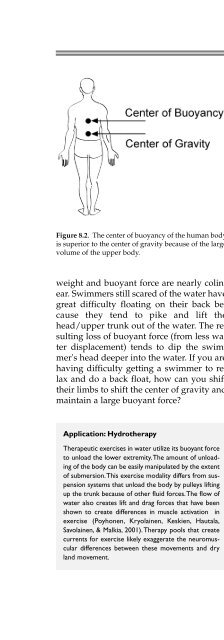Fundamentals of Biomechanics
Fundamentals of Biomechanics
Fundamentals of Biomechanics
You also want an ePaper? Increase the reach of your titles
YUMPU automatically turns print PDFs into web optimized ePapers that Google loves.
Figure 8.2. The center <strong>of</strong> buoyancy <strong>of</strong> the human body<br />
is superior to the center <strong>of</strong> gravity because <strong>of</strong> the large<br />
volume <strong>of</strong> the upper body.<br />
weight and buoyant force are nearly colinear.<br />
Swimmers still scared <strong>of</strong> the water have<br />
great difficulty floating on their back because<br />
they tend to pike and lift the<br />
head/upper trunk out <strong>of</strong> the water. The resulting<br />
loss <strong>of</strong> buoyant force (from less water<br />
displacement) tends to dip the swimmer's<br />
head deeper into the water. If you are<br />
having difficulty getting a swimmer to relax<br />
and do a back float, how can you shift<br />
their limbs to shift the center <strong>of</strong> gravity and<br />
maintain a large buoyant force?<br />
Application: Hydrotherapy<br />
Therapeutic exercises in water utilize its buoyant force<br />
to unload the lower extremity.The amount <strong>of</strong> unloading<br />
<strong>of</strong> the body can be easily manipulated by the extent<br />
<strong>of</strong> submersion.This exercise modality differs from suspension<br />
systems that unload the body by pulleys lifting<br />
up the trunk because <strong>of</strong> other fluid forces.The flow <strong>of</strong><br />
water also creates lift and drag forces that have been<br />
shown to create differences in muscle activation in<br />
exercise (Poyhonen, Kryolainen, Keskien, Hautala,<br />
Savolainen, & Malkia, 2001). Therapy pools that create<br />
currents for exercise likely exaggerate the neuromuscular<br />
differences between these movements and dry<br />
land movement.<br />
CHAPTER 8: FLUID MECHANICS 195<br />
We have seen that objects in a fluid experience<br />
a supporting force related to the<br />
position <strong>of</strong> the object in the fluid and the<br />
density <strong>of</strong> the object. The next section will<br />
deal with the interaction forces between an<br />
object and the fluid when there is relative<br />
motion between the two. These fluid motion<br />
forces can be quite large. The fluid<br />
forces between the air and your body are<br />
nearly identical if you are falling at 120<br />
km/hr while skydiving in a specific body<br />
position or if you are apparently still on top<br />
<strong>of</strong> a column <strong>of</strong> 120 km/hr airflow in a simulator.<br />
In both these situations the drag<br />
forces on the body are equal to your body<br />
weight. In the first case the body is falling<br />
through essentially still air while in the second<br />
case the body is essentially stationary<br />
with air flowing over it.<br />
Drag<br />
The fluid force resisting motion between an<br />
object and a fluid is called drag. Drag acts<br />
in the same direction (parallel) as the relative<br />
flow <strong>of</strong> the fluid past an object and in<br />
the opposite direction <strong>of</strong> the object's motion<br />
in the fluid. Drag forces act on the fisherman<br />
(creek) and the fly (air) due to the relative<br />
motion <strong>of</strong> the fluid past the objects<br />
(see Figure 8.3). If there are no propulsive<br />
forces acting on the object, like a projectile<br />
(see chapter 5, p. 113), the drag force tends<br />
to slow down the motion <strong>of</strong> the projectile<br />
through the fluid. Since the drag force acts<br />
parallel to the relative flow <strong>of</strong> the fluid, it is<br />
much like the contact force <strong>of</strong> friction studied<br />
in chapter 6.<br />
Research has shown that the size <strong>of</strong> the<br />
drag force (F D ) that must be overcome in a<br />
fluid can be calculated using the following<br />
formula: F D = ½C D A P V 2 . The coefficient<br />
<strong>of</strong> drag (C D ) is a dimensionless number<br />
much like the coefficient <strong>of</strong> friction or restitution.<br />
We will see later that C D depends on<br />
many object and fluid flow factors. Drag






